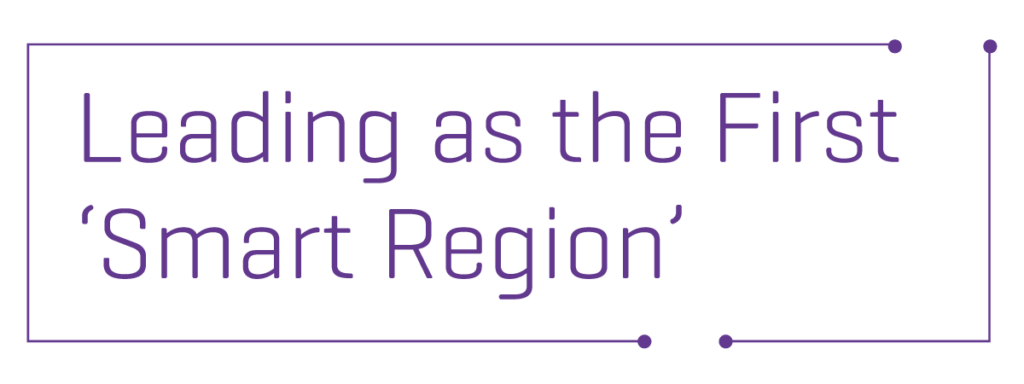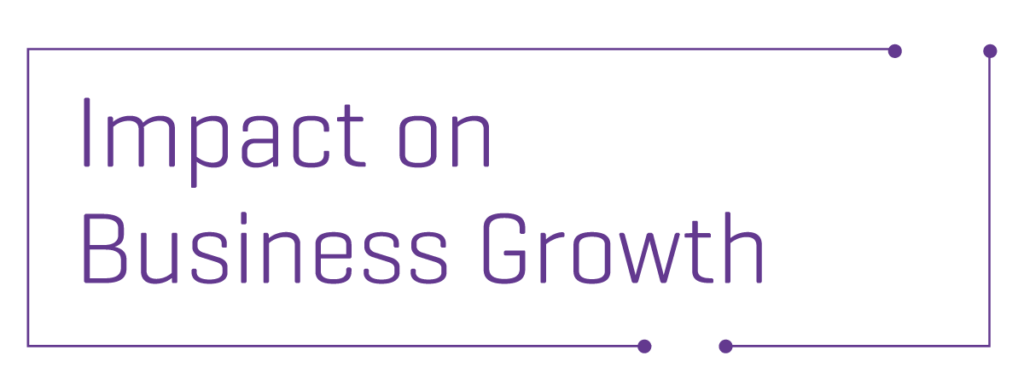 Having a lot of information doesn’t necessarily equate to being smart. With all our “smart” devices that generate mountains of data, what makes a difference in our lives is what we do with that information. Cities take that concept to a greater scale, benefitting both residents and business.
Having a lot of information doesn’t necessarily equate to being smart. With all our “smart” devices that generate mountains of data, what makes a difference in our lives is what we do with that information. Cities take that concept to a greater scale, benefitting both residents and business.
In fact, in terms of growing and attracting business, Chris Camacho, president and CEO of the Greater Phoenix Economic Council, notes, “Digital and smart technology are now considered the new-age infrastructure of the 21st century.”

Says Diana Bowman, Ph.D., co-director of ASU Center for Smart Regions and Cities, “When I think about what a smart city or region is, my first response really is framed around a jurisdiction that is focused on improving quality of life for its residents.” One example she offers is designing infrastructure that supports autonomous vehicles as a way to promote independence in an aging population and encourage aging in place. Another is delivering connectivity to as many people as possible, as access to the internet can open up new employment opportunities as well as deliver a range of educational opportunities that school-aged children may not have previously had access to. “Infrastructure is, therefore, critical to the evolution of a city to a smart city. But I would argue that the infrastructure should be viewed as the enabler for the delivery of services and opportunities that will drive quality-of-life improvement and promote, for example, sustainability.”
That requires a new way of looking at the information.
“Previously, we operated very well in silos, with organizations created around utilities, public safety, traffic, et cetera,” observes Jeff Dodge, digital innovation director at Insight. Insight, although not directly doing smart city work with Phoenix or Maricopa County, is strongly in that space, having evolved over the past 10 years from being a value-added reseller to an advanced-services provider, helping cities and other large entities understand how to deal with data from a secure perspective. Dodge notes, “Now, with advent of IoT [Internet of Things] and cameras everywhere, all information being created by independent entities is valuable to the other entities. And it is valuable to the private sector. In particular, it is valuable to the private citizenry.”
Mike Zeto, vice president of advanced mobility solutions at AT&T, explains that interoperability can be achieved in multiple ways. “Data can be sent to the cloud for external processing and send alerts to the appropriate parties, but it can also now be processed and analyzed at the edge [real-world usage, as opposed to data centers].” Noting that processing data locally significantly mitigates the risk of theft or illegal access, he says, “A smart city operations dashboard at the local level provides near real-time visibility into key metrics.”
Another direction is improvements in detection and relevant artificial intelligence and analytics through innovative sensors, big data and IoT. Vladimir Livshits, Ph.D., director of Transportation Technologies and Services at Maricopa Association of Governments, says, “MAG is currently deploying and evaluating technology pilots that are aimed at dramatically improving traffic operations and transportation safety in the region. These pilots are based on new detection devices and machine learning algorithms.” Data collection, traffic signal operations, lighting, parking and curbside management are just some examples of possible application of these new detection devices and related technologies.
“Smart cities or smart regions touch virtually every aspect of a city,” Zeto observes. And he sees this as just the beginning. “The deployment of 5G will jumpstart a new era of massive device connectivity. Low-latency, high speeds and ultra-reliability will enable even more use cases for cities. The deployment of 5G will help lay the groundwork for further smart cities developments such as traffic improvements, enhanced public safety and better building and infrastructure management.” [For more about 5G, see “5G Will Mark New Era for Businesses,” In Business Magazine, April 2019.]
“Developing smart region solutions involves not only technological aspects of the applications but, sometimes more importantly, political, economic, social, legal, environmental and organizational considerations,” says Dr. Livshits. Governments have an important role to play in accelerating and coordinating the development of smart regions and cities while maintaining the focus on the public good and implementing projects that benefit the community when dealing with complex issues. “They create environments where investments in smart infrastructure, transportation and public safety serve as incentives for job creation and economic growth.”

Innovative leadership is doing much more than moving individual entities from traditional silos to an integrated approach; our community leaders are taking the concept of integration within an organization or department and applying it regionally.
Camacho has observed a lot of cities across the U.S. adopting smart technology because a smart technology widget gets pushed upon a city council or a city staff; he refers to that as a solution seeking a problem. “Instead,” he says, “we’ve determined that you can unify a regional system of municipalities — in this case, 20-plus cities in the fastest-growing region in the United States — with CIOs, city managers, mayors and [other] elected officials working together to adopt a smart regional governance model that evaluates city — or, in this case, resident problem sets such as stop light and street light optimization — first.
“I haven’t seen this anywhere across the country, where you have all of these partners — the public sector to identify problem sets, and the backend industry partners to identify solution sets — and that’s what makes this overarching system unique.”
The inspiration came to him when he and a couple of his peers attended a smart city conference. “We saw this kind of siloed approach to smart technology adoption as almost like a fad.” They realized there was an opportunity to leverage GPEC’s system of regional coordination and collaboration with the cities it worked with and Maricopa County and the private sector. Upon reaching out to the various entities to assess interest in a unified approach, Camacho says, “We had overwhelming feedback that this could create a new disciplined way of adopting smart technology and advancing this digital framework — unlike any other place in the United States.” They branded the consortium “The Connective.”
Says Dr. Bowman, “Our approach with The Connective is that everyone in the region should be involved; a regional initiative needs to have everyone at the table — big or small, in terms of cities and towns — so that we are able to co-design what the vision of the region is. Key challenges facing the Greater Phoenix region — from transportation through to sustainability, for example — impact us all. In my view, recognizing that we can scale solutions quickly by working collaboratively has been one of the key drivers behind the cities, towns and county supporting The Connective.”
Camacho points out this also includes APS and SRP — our largest electrical utility providers. “Because of this movement, this reshaping at how we look at adopting smart technology, major utilities partnering with ASU and their smart campus plan to ensure that we have — much like we’ve advanced at the state level — sandboxes for testing and validating new technology.”
Another advantage we have in creating a smart region is a solid regional backbone, says Dr. Livshits. “One of the unique characteristics of this region is an extensive grid road network that provides an ample capacity for traffic movement.” He points out that travelers are not necessarily paying attention to municipal boundaries as they travel for work and play. “Shared and compatible infrastructure solutions can create a truly seamless travel experience and dramatically improve efficiency of the transportation infrastructure.” And he notes these solutions also allow municipalities to realize economies of scale.
Underlying this is a need for robust communication networks, points out Ian Linssen, assistant to the city manager for the City of Mesa. “Governments and the private sector alike are currently working on deploying and upgrading these networks,” he says, adding that data infrastructure — which includes general data governance, transparency and privacy, among other issues — is also key.
Noting that integrating the smart city systems is a crucial — and ongoing — effort, as shared and integrated data can be more efficient and effective, Linssen points to Mesa’s actions to accomplish this through a series of data governance policies, with information and access easily available through a data portal on the city’s website.
“A cross-silo data strategy perspective must be a city-wide data strategy; ideally, it needs to be an Arizona-wide data strategy,” emphasizes Dodge. This necessitates moving toward a standardized data strategy, with everyone collaborating “so that it’s comprehensive and can drive insights in real time.” This, in turn, will drive more proactive outcomes.
This, indeed, is the approach our region is taking. Says Livshits, “Jurisdictions at all levels and of all sizes have a role to play in implementing a ‘smart region.’ While larger agencies may be better able to support infrastructure investment, small agencies are well-positioned to take advantage of rapid deployment of lower-cost solutions.” He notes that coordination between these agencies can ease the testing and adoption of new technologies. “If there is agreement on standards of interoperability, a menu of options can be made available to suit every level of participation and investment.”

“Based on our experiences here in the Greater Phoenix region, all sectors — public, private, not-for-profit, academia and citizens more generally — have an important, and continuous, role to play in the development of a smart city or region,” says Dr. Bowman. “By creating a public-private partnership — The Connective — we have created the institutional framework that provides for all sectors to actively engage with the smart region, as well as provide a permanent structure to drive the smart region agenda.”
What are the roles on each side of this partnership? “Government plays a regulatory role — ensuring public safety, keeping the community informed about aesthetic considerations, for instance — and also helping to foster and deploy smart city technologies and best practices,” Linssen explains. “Private business develops the tech and works with government to deploy it.” In fact, Zeto has found that much of the initial investment required to implement the full range of smart city applications comes from the private sector, such as utilities and real estate developers.
Says Camacho, “Cities, very importantly, had to lean in and learn what the purpose was. And cities have the unique ties to individual residents’ communication on needs for communities, so obviously having them in the fold was really important to diagnose or appraise which city-led initiatives needed to be addressed. At that point, we’ll be able to continue to collect city feedback in this process that, ideally, will be able to unify in a multijurisdictional way these concerns or needs and then address them at scale.”
Camacho sees industry on the other side of this pendulum, where they’ll be able to give advice and support and thought leadership to the varying technology solutions that exist out in the marketplace today — which the cities, through the smart region connective, have appraised, assessed and are taking to market.
“And in the middle of this whole model,” he says, “you have GPEC, MAG, Institute for Digital Progress and ASU as all the key players enabling the public and private sectors to advance together.”
Dodge, whose work at Insight involves looking for repeatable patterns in the solutions Insight builds for clients so as to make it easier, faster and more efficient to deploy the solutions, believes what is most important is for the cities to get an understanding of what they have now, cross-functionally. “It’s a pivotal foundational element to figure out what is in place, where do they have fiber already, where are those fixed assets that they’ve already made investments in.” For instance, how can cities utilize light poles (under their Power department), cameras (under their Public Safety department), and other assets from both public and private commercial endeavors? He notes the cost to integrate existing assets is trivial compared to deploying new physical assets.
Once that assessment is made, Dodge says, cities can then figure out how to create wireless network connectivity layered on fixed assets. And he points out that enabling such connectivity are advances in 5G, small-cell and new radio frequencies that are becoming available. “This allows cities to deploy a vastly greater array of sensors, of additional technology assets, that don’t require very expensive or complicated action, such as laying new fiber or dealing with zoning and domain issues.”
Similarly beneficial to the cities from a cost perspective are smart cities crowdsourced solutions. These, Dr. Livshits points out, open the realm of possibilities for private, third-party data to monitor and operate infrastructure without costly instrumentation. For instance, the use of crowdsourced data can improve efficiency and effectiveness of transportation system management and operations for incident notification and vehicle-based travel time data for monitoring traffic bottlenecks.
Dr. Bowman comes back again to interoperability as key to a smart city or smart region, and believes that has been a real driving force behind the development of The Connective. “Interoperability recognizes that people move across jurisdictional boundaries all day, every day,” she says, “and having systems — albeit parking or traffic signals — that talk to each other allows for the streamlining of operations and greater efficiencies across the board.”
Infrastructure development, or upgrades, involved in creating smart capabilities can vary by region, notes Dr. Livshits, pointing out the impossibility of predicting all possible innovations or even an exact pace of deployment of existing technologies. “However,” he says, “MAG has recently published a Smart Region Technologies Report that provides examples of relevant smart region and smart city deployments in the MAG region and across the country. MAG’s research and efforts in deploying infrastructure technology pilots identified a number of major directions that are the most beneficial for the regional scale. This is the focus of MAG’s efforts as the regional planning agency and as a Council of Governments.
“One major direction is improvements in regional infrastructure connectivity and telecommunications,” Dr. Livshits continues, pointing out that communication infrastructure is key to the smart cities initiatives — specifically, the fiber optic network, which is essential to connect services like wireless, cellular, Wi-Fi, video and a large number of IoT devices and sensors that are capable of contributing to smart cities.
The Connective was designed to address the challenges and priorities of the Greater Phoenix region. Projects and vision for The Connective — many of which cross jurisdictional lines — are being determined by the cities and towns that make up the consortium. “Projects will be proposed and voted on by the cities and towns, and prioritized accordingly,” says Dr. Bowman, noting that this makes our approach very different from most smart city initiatives, which have, traditionally, been about the technology. “We are, instead, focused on finding solutions to the challenges identified in our region by those who live and work in the region,” she says.
Balancing data privacy and the perception of privacy are what Zeto sees as top issues of citizen engagement. He’s found this to be very common in public safety applications where the use of real-time data is valuable for improving response times and, ultimately, saving lives. Acknowledging that, for some, the mere mention of data might perk up a few ears, he points to AT&T’s implementation of a comprehensive slate of controls, policies and technologies to help protect people’s privacy as evidence of that issue’s top priority importance.
Data ownership is another big issue, as it affects governance across systems. Related concerns are transparency and confidentiality. Explains Dr. Livshits, “Businesses prioritize keeping data confidential to protect their edge in the market. Governments prioritize transparency as stewards of public trust and funding. These priorities can clash and jeopardize partnerships if not successfully resolved. Further, as public entities, governments prioritize the privacy of citizens and their data.” He believes transparency will be key for citizens, so they understand where their data is going and who is controlling access to that data, with cybersecurity also a key part of the evaluation and implementation of any smart region technologies deployed by agencies, to protect citizen data and the security of infrastructure.
“Cybersecurity and data governance is something we covered early on in this process because access to data and sensitivity of data and even ownership of data in the public domain is critically important,” Camacho says. Through The Connective, the cities are going to have the ability to silo off their data and secure their data with their residents. “There will be opportunities for interoperability, and we’re working with CIOs now,” Camacho says. The integration of technology with infrastructure can provide many benefits to cities, but it also introduces new cyber threats to critical infrastructure, such as water, communications, power and transportation, that must be considered, Zeto points out. “Cities are seeing an increase in ransomware and denial of service attacks, which are responsible for billions of dollars of impact annually.”
How to deal with data from a secure perspective is one angle. Another is clean data, which, Dodge shares, is currently one of the biggest problems. “Everyone has tons of data, but how do you rationalize that data,? What is your overarching strategy to make sure not bringing in garbage?” he asks, referring to adage, “Garbage in, garbage out.” This is one example of how private business fits into the equation, as Insight leverages the significant investment it has made over the last 30 years to become a super-solution integrator, not just procuring the infrastructure but putting where needs to be, maintaining and managing the assets.
There are many regulatory issues. Privacy concerns, procurement, liability and utilization of different funding sources are a few examples that Dr. Livshits shares. Zeto points also to the need for cities to consider the impact of infrastructure-related regulations, which could include permitting for communications infrastructure that enables smart cities, like small cells, or permitting for smart cities technology that enables citizen engagement, like digital kiosks.
Linssen, noting that public safety is priority number one, says there may be instances of legacy regulations needing to be reexamined to better allow for the promotion and adoption of emerging smart city tech. Emphasizing that Mesa has yet to contemplate such a regulatory change, he offers as one example of potential change the way the city makes available city facilities, such as buildings and towers, for smart city opportunities. “A hypothetical example might include city facilities like government building rooftops being used to house smart city technologies.”
“One key aspect of the smart city is knowing that government does not have all the answers,” says Christine Mackay, director of Community and Economic Development for the City of Phoenix. “By partnering with the private sector, Phoenix is able to draw upon the unique problem-solving skills of its business community.”
Support goes both ways. “Government investment has traditionally spurred innovation,” observes Dr. Livshits. “There are unique opportunities to improve citizens’ lives in partnership with businesses. Business will gain access to ‘living laboratories,’ reputational capital and solutions developed for government that will be ready for commercial applications.”
In fact, Dr. Livshits notes that private businesses often serve as catalysts for technological change, and they are often expert advisors and partners on infrastructure projects. “While government can accelerate and facilitate technological advancements and economic growth by creating a favorable environment and through targeted investments, it is often the role of the private sector to develop innovative technological infrastructure solutions. The private sector also is often tasked with implementing them — in close collaboration or partnership with governmental organizations.”
And Zeto points out that many of the technologies used to create smart cities provide benefits for businesses, too. “AT&T has seen this in our own operations. We began using the IoT-enabled Building Energy Management system in late 2015. By the end of 2017, we were collecting more than 1.2 million data points associated with 27,000 pieces of equipment at more than 350 facilities. Today, we’re seeing nearly $1 million in annual electricity savings and more than 5,000 metric tons of CO2e savings.”
“There are going to be partnerships that are born between ASU and the utilities to advance the testing and validation of smart technology,” Camacho says. “So this is a multi-faceted model. If the smart technology is readily available to be consumed by the public enterprises, then we’ll do that; if these technologies need further validation, we’ll be able to conduct additional testing and validation upon research, within these regulatory frameworks — and that’s another big piece that’s not happening nationally.”
In this new era of digital infrastructure, Camacho sees The Connective as an ecosystem of testing and validating smart technologies to get them to prime time so they’re ready to be adopted by the public at scale. “It seamlessly ties into our ability to recruit companies, because companies nationally and internationally want markets that are digitally connected, that have modern infrastructure. So we do feel, absolutely, that this kind of strategy that GPEC has been working on for now a few years puts Greater Phoenix in a position to not only be smart about how they adopt smart technology, but, over time as we produce this kind of connectivity — smart campuses, smart utility strategies — to be in a unique cut of markets that are advancing the identity of the region, which is very globally technology-enabled.”
Dominic Papa, VP of the Smart State Initiative at the Arizona Commerce Authority, emphasizes that smart cities need all levels of government working together to drive a unified, policy-driven approach to their digital transformation. “The model that we are seeing be the most successful is a new type of public-private-nonprofit consortium,” he says, explaining, “The ability for a technology and innovation nonprofit to provide an independent, neutral platform for both the public sector and the private sector to come together in a trusted environment to collaboratively deploy technology and infrastructure is what really sets this new evolution of smart cities apart. The nonprofit, as the community-facing organization, can be the home for the city’s digital agenda and strategy and can assure the sustainability of the effort by being politically independent of the government and ensure its continued success beyond election cycles.” The significance of this, he says, is it provides a level of trust for the private sector that encourages them to invest in the community and their plans for the future.
“We’re in the first inning of a long game, and we believe the right approach to adopting smart technology is identifying problems first that could be solved through multi-jurisdictional coordination, and then bringing in universities and transportation partners and others,” Camacho says. “Ultimately, we can produce cross-renovation with the private sector then to adopt these solutions at scale instead of incrementally adopting solutions based upon being pushed by the industry.”
Says Papa, “There is no doubt that the new role for government is to foster collaboration. Collaboration is the new competitive advantage for cities. Those cities that figure out how to collaborate the best will find themselves at the forefront of technology and innovation. Those cities that fail to collaborate will become part of the fourth Industrial Revolution’s digital dustbowl.”
Camacho says he expects the first call for innovation to occur at the end of the first quarter of 2020. “We’ve spent the last 24 months building a governance model to be sure we had all the right people involved — which is a mighty feat — but now the real work begins. We have to execute against these culture innovations.”













Speak Your Mind
You must be logged in to post a comment.